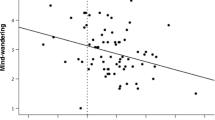Abstract
This study presents two experiments that explored consolidation of implicit sequence learning based on two dependent variables—reaction time (RT) and correct anticipations to clarify the role of sleep, and whether the manual component is necessary for consolidation processes. Experiment 1 (n = 37) explored the performance of adults using an ocular variant of the serial reaction time task (O-SRT) with manual activation (MA), and Experiment 2 (n = 37) used the ocular activation (OA) version of the task. Each experiment consisted of a Day and a Night group that performed two sessions of the O-SRT with an intervening 12-h offline period (morning/evening in Day group, evening/following morning in Night group). Night offline had an advantage only when manual response was required and when correct anticipations (i.e., accuracy) but not RT (i.e., speed) were measured. We associated this finding with the dual-learning processes required in the MA O-SRT that led to increased sequence specific learning overnight. When using the OA O-SRT, both groups demonstrated similar rates after offline in RT and correct anticipations. We interpreted this finding to reflect stabilization, which confirmed our hypothesis. As expected, all the groups demonstrated reduced performance when another sequence was introduced, thus reflecting sequence-specific learning. This study used a powerful procedure that allows measurement of implicit sequence learning in several ways: by evaluating two different measures (RT, correct anticipations) and by isolating different aspects of the task (i.e., with/without the manual learning component, more/less general skill learning), which are known to affect learning and consolidation.










Similar content being viewed by others
Availability of data and material
The datasets generated during and/or analyzed during the current study are available from the corresponding author on reasonable request.
References
Albouy, G., Ruby, P., Phillips, C., Luxen, A., Peigneux, P., & Maquet, P. (2006). Implicit oculomotor sequence learning in humans: Time course of offline processing. Brain Research, 1090(1), 163–171. https://doi.org/10.1016/j.brainres.2006.03.076
Csábi, E., Benedek, P., Janacsek, K., Zavecz, Z., Katona, G., & Nemeth, D. (2016). Declarative and non-declarative memory consolidation in children with sleep disorder. Frontiers in Human Neuroscience, 9, 709. https://doi.org/10.3389/fnhum.2015.00709
Csabi, E., Varszegi-Schulz, M., Janacsek, K., Malecek, N., & Nemeth, D. (2014). The consolidation of implicit sequence memory in obstructive sleep apnea. PLoS ONE, 9(10), 1–6. https://doi.org/10.1371/journal.pone.0109010
Deroost, N., & Soetens, E. (2006). Perceptual or motor learning in SRT tasks with complex sequence structures. Psychological Research Psychologische Forschung, 70(2), 88–102. https://doi.org/10.1007/s00426-004-0196-3
Diekelmann, S., Wilhelm, I., & Born, J. (2009). The whats and whens of sleep-dependent memory consolidation. Sleep Medicine Reviews, 13(5), 309–321. https://doi.org/10.1016/j.smrv.2008.08.002
Doyon, J. (2008). Motor sequence learning and movement disorders. Current Opinion in Neurology, 1(4), 478–483. https://doi.org/10.1097/WCO.0b013e328304b6a3
Doyon, J., Korman, M., Morin, A., Dostie, V., Tahar, A. H., & Benali, H. (2009). Contribution of night and day sleep vs. simple passage of time to the consolidation of motor sequence and visuomotor adaptation learning. Experimental Brain Research, 195(1), 15–26. https://doi.org/10.1007/s00221-009-1748-y
Ferraro, F. R., Balota, D. A., & Connor, L. T. (1993). Implicit memory and the formation of new associations in nondemented Parkinson’s disease individuals and individuals with senile dementia of the Alzheimer type: A serial reaction time (SRT) investigation. Brain and Cognition, 21, 163–180. https://doi.org/10.1006/brcg.1993.1013
Fischer, S., Drosopoulos, S., Tsen, J., & Born, J. (2006). Implicit learning–explicit knowing: A role for sleep in memory system interaction. Journal of Cognitive Neuroscience, 18(3), 311–319. https://doi.org/10.1162/jocn.2006.18.3.311
Helmuth, L. L., Mayr, U., & Daum, I. (2000). Sequence learning in Parkinson’s disease: a comparison of spatial-attention and number-response sequences. Neuropsychologia, 38(11), 1443–1451. https://doi.org/10.1016/S0028-3932(00)00059-2
Janacsek, K., & Nemeth, D. (2012). Predicting the future: from implicit learning to consolidation. International Journal of Psychophysiology, 83(2), 213–221. https://doi.org/10.1016/j.ijpsycho.2011.11.012
Krakauer, J. W., & Shadmehr, R. (2006). Consolidation of motor memory. Trends in Neurosciences, 29(1), 58–64. https://doi.org/10.1016/j.tins.2005.10.003
Kühnel, A., Gaschler, R., Frensch, P. A., Cohen, A., & Wenke, D. (2019). Lack of automatic vocal response learning while reading aloud – An implicit sequence learning study. Experimental Psychology, 66(4), 266–280. https://doi.org/10.1027/1618-3169/a000451
Lakens, D., Scheel, A. M., & Isager, P. M. (2018). Equivalence testing for psychological research: A tutorial. Advances in Methods and Practices in Psychological Science, 1(2), 259–269.
Marcus, D. J., Karatekin, C., & Markiewicz, S. (2006). Oculomotor evidence of sequence learning on the serial reaction time task. Memory & Cognition, 34(2), 420–432. https://doi.org/10.3758/BF03193419
Meier, B., & Cock, J. (2014). Offline consolidation in implicit sequence learning. Cortex, 57, 156–166. https://doi.org/10.1016/j.cortex.2014.03.009
Nemeth, D., Gerbier, E., & Janacsek, K. (P 2019). Four pitfalls in sleep and memory research and how to avoid them. 2019080208 https://doi.org/10.20944/preprints201908.0208.v1
Nemeth, D., Janacsek, K., Londe, Z., Ullman, M. T., Howard, D. V., & Howard, J. H., Jr. (2010). Sleep has no critical role in implicit motor sequence learning in young and old adults. Experimental Brain Research, 201(2), 351–358. https://doi.org/10.1007/s00221-009-2024-x
Nissen, M. J., & Bullemer, P. (1987). Attentional requirements of learning: Evidence from performance measures. Cognitive Psychology, 19(1), 1–32. https://doi.org/10.1016/0010-0285(87)90002-8
Reber, A. S. (1989). Implicit learning and tacit knowledge. Journal of Experimental Psychology: General, 118(3), 219. https://doi.org/10.1037/0096-3445.118.3.219
Robertson, E. M. (2009). From creation to consolidation: a novel framework for memory processing. PLoS Biology, 7(1), e1000019. https://doi.org/10.1371/journal.pbio.1000019
Robertson, E. M., Pascual-Leone, A., & Press, D. Z. (2004). Awareness modifies the skill-learning benefits of sleep. Current Biology, 14(3), 208–212. https://doi.org/10.1016/j.cub.2004.01.027
Savic, B., & Meier, B. (2016). How transcranial direct current stimulation can modulate implicit motor sequence learning and consolidation: A brief review. Frontiers in Human Neuroscience, 10, 26. https://doi.org/10.3389/fnhum.2016.00026
Schwarb, H., & Schumacher, E. H. (2012). Generalized lessons about sequence learning from the study of the serial reaction time task. Advances in Cognitive Psychology, 8(2), 165–178. https://doi.org/10.2478/v10053-008-0113-1
Schwizer Ashkenazi, S., Sacher, Y., & , Vakil, E. . (2020). New insights in implicit sequence learning of adults with traumatic brain injury: as measured by an ocular serial reaction time (O-SRT) task. Neuropsychology. https://doi.org/10.1037/neu0000710 Advance online publication.
Simor, P., Zavecz, Z., Horváth, K., Éltető, N., Török, C., Pesthy, O., Gombos, F., Janacsek, K., & Nemeth, D. (2019). Deconstructing procedural memory: Different learning trajectories and consolidation of sequence and statistical learning. Frontiers in Psychology, 9, 2708. https://doi.org/10.3389/fpsyg.2018.02708
Song, S. (2009). Consciousness and the consolidation of motor learning. Behavioral Brain Research, 196(2), 180–186. https://doi.org/10.1016/j.bbr.2008.09.034
Song, S., Howard, J. H., & Howard, D. V. (2007). Sleep does not benefit probabilistic motor sequence learning. The Journal of Neuroscience, 27(46), 12475–12483. https://doi.org/10.1523/JNEUROSCI.2062-07.2007
Song, S., Howard, J. H., & Howard, D. V. (2008). Perceptual sequence learning in a serial reaction time task. Experimental Brain Research, 189(2), 145–158. https://doi.org/10.1007/s00221-008-1411-z
Urbain, C., Schmitz, R., Schmidt, C., Cleeremans, A., Van Bogaert, P., Maquet, P., & Peigneux, P. (2013). Sleep-dependent neurophysiological processes in implicit sequence learning. Journal of Cognitive Neuroscience, 25(11), 2003–2014. https://doi.org/10.1162/jocn_a_00439
Vakil, E., Bloch, A., & Cohen, H. (2017). Anticipation measures of sequence learning: manual versus oculomotor versions of the serial reaction time task. The Quarterly Journal of Experimental Psychology, 70, 579–589. https://doi.org/10.1080/17470218.2016.1172095
Vakil, E., Kahan, S., Huberman, M., & Osimani, A. (2000). Motor and non-motor sequence learning in patients with basal ganglia lesions: The case of serial reaction time (SRT). Neuropsychologia, 38, 1–10. https://doi.org/10.1016/S0028-3932(99)00058-5
Vakil, E., Kraus, A., Bor, B., & Groswasser, Z. (2002). Impaired skill learning in patients with severe closed-head injury as demonstrated by the serial reaction time (SRT) task. Brain and Cognition, 50, 304–315. https://doi.org/10.1016/S0278-2626(02)00515-8
Yonelinas, A. P., Ranganath, C., Ekstrom, A. D., & Wiltgen, B. J. (2019). A contextual binding theory of episodic memory: systems consolidation reconsidered. Nature Reviews Neuroscience, 20(6), 364–375. https://doi.org/10.1038/s41583-019-0150-4
Yotsumoto, Y., Watanabe, T., Chang, L. H., & Sasaki, Y. (2013). Consolidated learning can be susceptible to gradually-developing interference in prolonged motor learning. Frontiers in Computational Neuroscience, 7(69), 1–8. https://doi.org/10.3389/fncom.2013.00069
Ziessler, M., & Nattkemper, D. (2001). Learning of event sequences is based on response-effect learning: further evidence from a serial reaction task. Journal of Experimental Psychology: Learning, Memory, and Cognition, 27(3), 595–613. https://doi.org/10.1037/0278-7393.27.3.595
Zirngibl, C., & Koch, I. (2002). The impact of response mode on implicit and explicit sequence learning. Experimental Psychology, 49, 153–162. https://doi.org/10.1027//1618-3169.49.2.153
Funding
This work was supported by the Farber Alzheimer's Center Foundation. This sponsor had no role in writing the review or in the decision to submit the article for publication.
Author information
Authors and Affiliations
Corresponding author
Ethics declarations
Conflicts of interest/competing interests
The authors report no conflicts of interest or competing interests.
Additional information
Publisher's Note
Springer Nature remains neutral with regard to jurisdictional claims in published maps and institutional affiliations.
Rights and permissions
About this article
Cite this article
Vakil, E., Hayout, M., Maler, M. et al. Day versus night consolidation of implicit sequence learning using manual and oculomotor activation versions of the serial reaction time task: reaction time and anticipation measures. Psychological Research 86, 983–1000 (2022). https://doi.org/10.1007/s00426-021-01534-1
Received:
Accepted:
Published:
Issue Date:
DOI: https://doi.org/10.1007/s00426-021-01534-1




